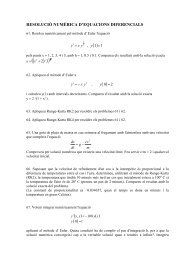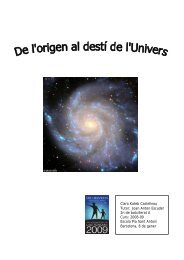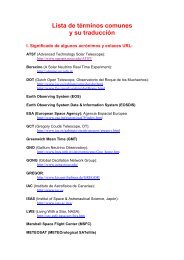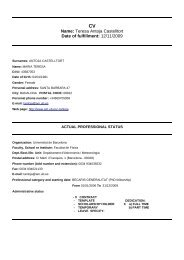Universitat de - Departament d'Astronomia i Meteorologia ...
Universitat de - Departament d'Astronomia i Meteorologia ...
Universitat de - Departament d'Astronomia i Meteorologia ...
You also want an ePaper? Increase the reach of your titles
YUMPU automatically turns print PDFs into web optimized ePapers that Google loves.
2.4. The radio counterpart: NVSS J182614−145054 37<br />
The existence of a radio counterpart to LS 5039 was first suspected after inspec-<br />
tion of the corresponding NVSS image. The 24 mJy source NVSS J182614−145054<br />
lied outsi<strong>de</strong>, but very close to, the 90% confi<strong>de</strong>nce error circle of RX J1826.2−1450,<br />
with 22 ′′ radius. This was the RASS source i<strong>de</strong>ntified with LS 5039 by M97. These<br />
authors also quoted another pointed ROSAT observation that yiel<strong>de</strong>d a 90% con-<br />
fi<strong>de</strong>nce radius of 35 ′′ , again consistent with NVSS J182614−145054. In addition,<br />
the NVSS coordinates were found to agree within 2 ′′ with the optical position of<br />
LS 5039, as <strong>de</strong>rived from the USNO-A1.0 catalog (Monet 1996, Monet et al. 1999).<br />
All these coinci<strong>de</strong>nces together stimulated our interest about this source and<br />
lead us to carry out higher resolution radio observations. This was consi<strong>de</strong>red to<br />
be the next logical step in or<strong>de</strong>r to better measure both its position and spectral<br />
properties. Therefore, we conducted a multiepoch and multifrequency radio study<br />
of LS 5039 with the VLA.<br />
2.4.2 VLA observations, discovery of a REXB<br />
Observations and results<br />
We observed 8 LS 5039 on several epochs at the wavelengths of 20, 6, 3.6 and 2.0 cm<br />
with the Very Large Array (VLA) interferometer of the NRAO 9 . The VLA data were<br />
processed following standard procedures within the aips package of NRAO. 3C 286<br />
was used as the amplitu<strong>de</strong> calibrator, while the phase calibrators observed were<br />
1834−126 at 20 cm, 1820−254 at 6 and 3.6 cm, and 1911−201 at 2 cm, respectively.<br />
The results of the interferometric runs on LS 5039 are summarized in Table 2.1,<br />
where the flux <strong>de</strong>nsity at several wavelengths is listed for the different observing<br />
dates. Some 20 cm values collected from the literature have been also inclu<strong>de</strong>d. The<br />
VLA data obtained in A configuration were further concatenated at 3.6 and 2.0 cm<br />
in or<strong>de</strong>r to obtain very sensitive sub-arcsec resolution maps. These are displayed in<br />
Fig. 2.2, where LS 5039 appears always as an unresolved point source (≤ 0.1 ′′ ). For<br />
the epochs when nearly simultaneous multifrequency observations are available, we<br />
have plotted in Fig. 2.3 the observed radio spectrum of LS 5039.<br />
8 Published in Martí, J., Pare<strong>de</strong>s, J. M. & Ribó, M. 1998, A&A, 338, L71.<br />
9 The National Radio Astronomy Observatory is a facility of the USA National Science Foun-<br />
dation operated un<strong>de</strong>r cooperative agreement by Associated Universities, Inc.






